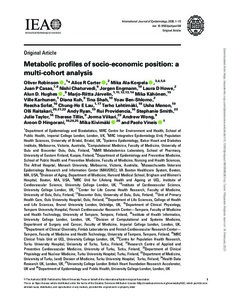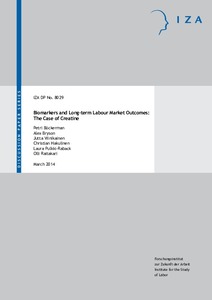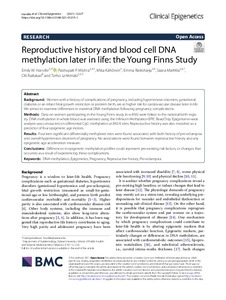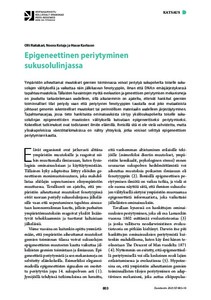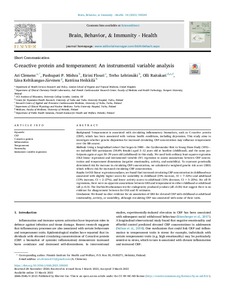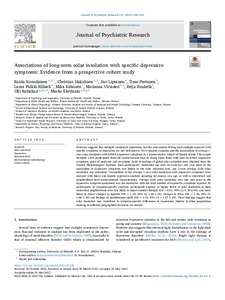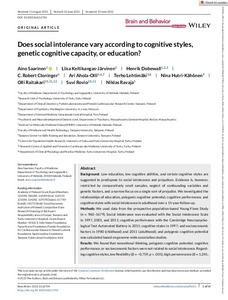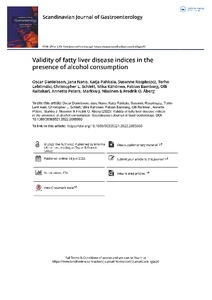Hae
Aineistot 21-30 / 35
Metabolic profiles of socio-economic position: a multi-cohort analysis
<div><p><strong>Background: </strong>Low socio-economic position (SEP) is a risk factor for multiple health outcomes, but its molecular imprints in the body remain unclear.</p><p><strong>Methods: </strong>We examined SEP ...
Biomarkers and long-term labour market outcomes: the case of creatine
<div>
Using the Young Finns Study (YFS) combined with the Finnish Linked Employer-Employee</div>
<div>
Data (FLEED) we show that quantities of creatine measured in 1980 prior to labour market</div>
<div>
entry ...
Reproductive history and blood cell DNA methylation later in life: the Young Finns Study
<div><p><strong>Background: </strong> Women with a history of complications of pregnancy, including hypertensive disorders, gestational diabetes or an infant fetal growth restriction or preterm birth, are at higher risk ...
Uncovering the complex genetics of human temperament
<p>Experimental studies of learning suggest that human temperament may
depend on the molecular mechanisms for associative conditioning, which
are highly conserved in animals. The main genetic pathways for
associative ...
Birth weight, adult weight, and cardiovascular biomarkers: Evidence from the Cardiovascular Young Finns Study
This study quantifies the causal effect of birth weight on cardiovascular biomarkers in adulthood using the Cardiovascular Risk in Young Finns Study (YFS). We apply a multivariable Mendelian randomization (MVMR) method ...
Epigeneettinen periytyminen sukusolulinjassa
Ympäristön aiheuttamat muutokset geenien toiminnassa voivat periytyä sukupolvelta toiselle sukusolujen välityksellä ja vaikuttaa näin jälkikasvun fenotyyppiin, ilman että {DNA}:n emäsjärjestyksessä tapahtuu muutoksia. ...
C-reactive protein and temperament: An instrumental variable analysis
<div><p><strong>Background: </strong> Temperament is associated with circulating inflammatory biomarkers, such as C-reactive protein (CRP), which has been associated with various health conditions, including depression. ...
Associations of long-term solar insolation with specific depressive symptoms: Evidence from a prospective cohort study
<p>Evidence suggests that sunlight counteracts depression, but the associations of long-term sunlight exposure with specific symptoms of depression are not well known. We evaluated symptom-specific associations of average ...
Does social intolerance vary according to cognitive styles, genetic cognitive capacity, or education?
<p>Background<br>Low education, low cognitive abilities, and certain cognitive styles are suggested to predispose to social intolerance and prejudices. Evidence is, however, restricted by comparatively small samples, neglect ...
Validity of fatty liver disease indices in the presence of alcohol consumption
<p><strong>Background & aims: </strong>Non-alcoholic fatty liver disease (NAFLD) and alcohol-related liver disease frequently coexist. While several blood-based indices exist for the detection of NAFLD, few studies have examined how alcohol use possibly impacts their diagnostic performance. We analysed the effects of alcohol use on the performance of indices for detecting fatty liver disease (FLD).</p><p><strong>Methods: </strong>We included participants from the Cardiovascular Risk in Young Finns Study (Finnish sample) and KORA study (German sample) who underwent abdominal ultrasound or magnetic resonance imaging, respectively, for detection of FLD and had serum analyses available for calculation of Fatty Liver Index (FLI), Hepatic Steatosis Index (HSI), Lipid Accumulation Product (LAP), and Dallas Steatosis Index (DSI). Alcohol use was estimated by questionnaires as mean daily consumption and binge drinking (Finnish sample only). Predictive performance for FLD was assessed according to alcohol consumption.</p><p><strong>Results: </strong>The study included 1426 (Finnish sample) and 385 (German sample) individuals, of which 234 (16%) and 168 (44%) had FLD by imaging. When alcohol consumption was <50 g/day, all indices discriminated FLD with area under the receiver operating characteristics (AUROC) of 0.82-0.88. AUROCs were 0.61-0.66 among heavy drinkers (>50 g/day). AUROCs decreased to 0.74-0.80 in the highest binge-drinking category (>2 times/week). Alcohol use correlated with FLI and LAP (r-range 0.09-0.16, p-range <.001-.02) in both samples and with DSI (r = 0.13, p < .001) in the Finnish sample.</p><p><strong>Conclusions: </strong>Indices perform well and comparably for detection of FLD with alcohol consumption <50 g/day and with different binge-drinking behaviour.</p>...
